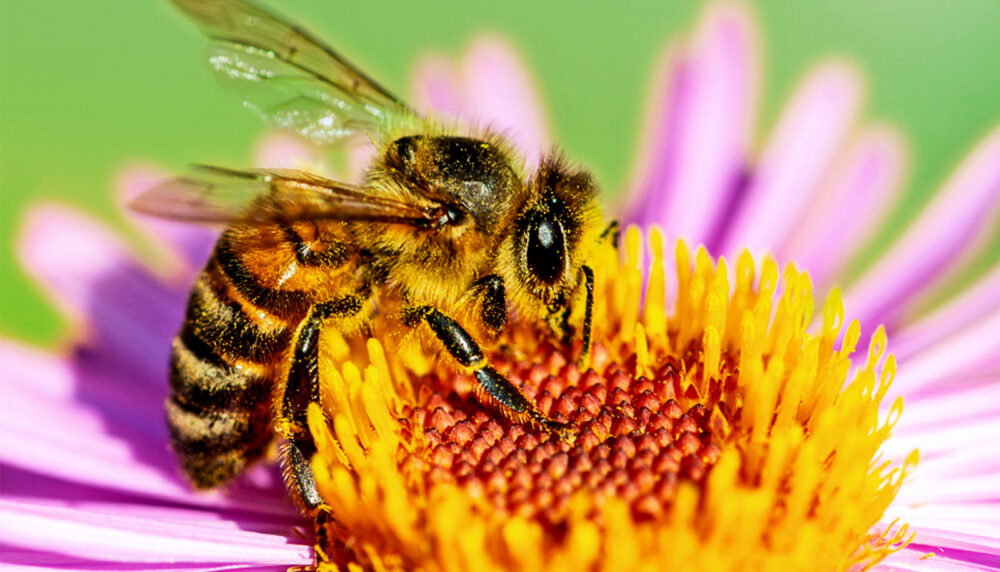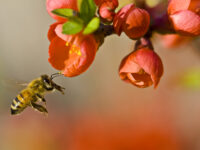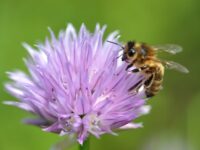Amidst the “save the bees” movement, honey bees tend to dominate the spotlight, and it is easy to understand why. The western honey bee, Apis mellifera, is utilized in agriculture around the world. Farmers in the United States rely on the fuzzy, charismatic insect to pollinate nearly 100 different crops, and, of course, for the millions of pounds of sticky-sweet honey it provides to Americans each year. The A. mellifera is so common throughout North America that many do not realize it is not native to the region; rather, the western honey bee is what scientists refer to as a “massively introduced managed species” (MIMS). It was imported to North America hundreds of years ago in enormous numbers and has been raised domestically ever since. In recent years, many managed A. mellifera colonies have struggled, resulting in a sea of media attention and calls to save the bees. While this attention towards honey bees is certainly deserved, there are close to 4,000 native bee species in North America that the public rarely thinks about. These wild bees are just as important as honey bees, but they have been suffering behind the scenes for years.
“Wild bee populations in North America, and around the world, currently face a myriad of threats.”
Wild bees are vital to the success of both natural ecosystems and agriculture. Most wild plants rely on pollination by bees and other insects to reproduce. The presence of a wide diversity of pollinators helps an ecosystem to be more resilient to negative environmental changes like those posed by climate change. The more bee species that thrive, the more likely it is that one or more will be able to adapt to a dramatic change in the environment and continue the crucial role of pollinating native plants. Wild bees are also highly beneficial in food production. Even when managed bees are imported to pollinate crops, the presence of a diverse wild bee community has been shown to increase pollination rates and crop yields. In 2016, Cornell researchers observed that when wild bees become more abundant in apple orchards, each fruit produces more seeds, but when honey bees become more abundant, seed production does not increase. Their study suggests that, in some cases, wild bees are more effective pollinators than only honey bees.
Unfortunately, wild bee populations in North America, and around the world, currently face a myriad of threats. Humans have fragmented and destroyed much of their habitat by clearing massive expanses of land and replacing diverse plant communities with crop monocultures. The widespread use of pesticides has exposed native bees to toxins that can cause neurological damage, weakened immunity, or death. Increasing temperatures and intense precipitation events associated with climate change also imperil native bees. Honey bees are vulnerable to many of the same threats and struggle particularly with pathogens and parasites. But while the plight of honey bees has earned broad media attention, wild bees have received close to none.
“Much research still needs to be conducted to understand the interactions between managed and wild bees and to determine the best path forward in protecting both.”
Not only does the fight to protect the A. mellifera often overshadow the plight of native bees, but some evidence suggests that managed honey bee populations themselves can be harmful to native bees. Honey bees are social insects that live packed together at high densities, making their colonies ideal reservoirs for diseases that may be transmitted to native bees. Additionally, when managed bees are imported to areas outside of their natural range, they can bring foreign pathogens with them. Managed bees may also compete with wild bees for floral resources. Researchers from the Doñana Biological Station in Spain found that when honey bees were introduced to the Canary Islands, the diversity of native pollinators decreased, with native bee species that rely on the same plants as honey bees being the most affected. Much research still needs to be conducted to understand the interactions between managed and wild bees and to determine the best path forward in protecting both. However, there are steps that can be taken now to safeguard wild bees along with the ecosystems and agriculture that depend on them. Beekeepers can limit the impact of managed bees on native populations by frequently screening their colonies for pathogens and by positioning their hives as far away from native habitats as possible to reduce the chance of competition with wild bees. Avoiding the use of chemical pesticides and instead turning to alternative methods of pest management can minimize bees’ exposure to lethal toxins. Finally, actions to reduce greenhouse gas emissions and minimize climate change are crucial to protecting these precious pollinators. Now is the time to act to save the bees — not just honey bees, but all bees.
Agriculture, Ecosystems, and Environment (2016). DOI: 10.1016/j.agee.2016.01.004
Nature (2016). DOI: https://doi.org/10.1038/nature20588
PLOS ONE (2017). DOI: 10.1371/journal.pone.0189268
Scientific Reports (2019). DOI: 10.1038/s41598-019-41271-5


